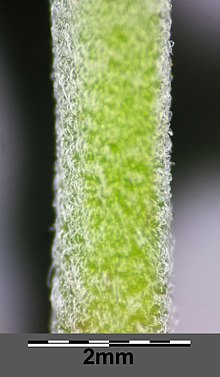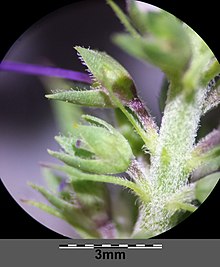Long-leaved speedwell
| Long-leaved speedwell | ||||||||||||
|---|---|---|---|---|---|---|---|---|---|---|---|---|

Long-leaved speedwell ( Veronica longifolia ) |
||||||||||||
| Systematics | ||||||||||||
|
||||||||||||
| Scientific name | ||||||||||||
| Veronica longifolia | ||||||||||||
| L. |
Veronica longifolia ( Veronica longifolia L. and Veronica maritima L. ) - also called in some overviews Langblättriger Blue loosestrife ( Pseudolysimachion longifolium (L.) Opiz out) - is a flowering plant in the family of Plantain Family (Plantaginaceae). This relatively large speedwell species grows particularly in river valleys.
description
Vegetative characteristics
The long-leaved speedwell is a perennial herbaceous plant that reaches heights of 60 to 100 (to 120) centimeters. The upright, glandless stem has hairs pointing downwards in the upper part. The lanceolate stem leaves are pointed and sharply serrated on the edge.
In the subspecies Veronica longifolia subsp. longifolia , the leaf base is clipped to heart-shaped; the mostly opposite leaves are a bit wider (up to four centimeters) and sawn more regularly. In the subspecies Veronica longifolia subsp. maritima , the three to four whorled leaves are rather narrow-lanceolate, more irregularly serrated and the leaf base is wedge-shaped. The distinction between the subspecies is still taxonomically controversial.
Generative characteristics
Between June and August the long-leaved speedwell develops conspicuous racemose inflorescences . These are arranged like many flowers and spikes. The blue (rarely blue-purple) flower is funnel-shaped; the flower tube is longer than it is wide.
The number of chromosomes is 2n = 68 or 34.
Occurrence
The distribution area is Nordic-Eurasian-continental. It includes Europe and the temperate zones of Asia. In Germany the western limit of the distribution is reached.
In Germany, the long-leaved speedwell can be found in the north with a scattered frequency along the larger river valleys (for example on the Lower Rhine , the Ems , the Aller , the Elbe , the Havel and the Oder ). It is seldom found in the south, mainly in the Rhine - Main area and on the Danube .
The long-leaved speedwell is a river valley plant that thrives in damp riparian perennials , on floodplain bushes, in bog meadows and on ditches. The locations are usually wet to wet, rich in nutrients and bases; Above all, there are musty-humic clay or peat soils, but also sandy loam soils. The species is a light and partial shade plant that needs warmth. According to Ellenberg , it is also a weak acid to weak base pointer and an association character of meadowsweet shorelines (Filipendulion ulmariae). According to Oberdorfer, it is even a character species of the Veronico longifoliae-Euphorbietum palustris in Central Europe.
Systematics
The distinction between subspecies is controversial; some authors separate according to:
- Veronica longifolia L. subsp. longifolia : It has chromosome number 2n = 68.
- Veronica longifolia subsp. maritima (L.) Soó & Borsos : It has the number of chromosomes 2n = 34.
In more recent botanical overviews, Veronica maritima L. now seems to establish itself as a species name or it becomes a collective species Veronica longifolia agg. from Veronica longifolia s. st. and Veronica maritima .
natural reserve
The long-leaved honorary award is "particularly protected" according to the Federal Species Protection Ordinance and is classified as "endangered" in the Red List of Germany. He is flower of the year 2018.
use
The long-leaved speedwell is also cultivated as an ornamental plant. There are several varieties in purple, blue and white; also hybrids with the spiked speedwell ( Veronica spicata syn .: Pseudolysimachion spicatum ). The ornamental plants grow wild easily; in isolated occurrences in the landscape, especially outside of river valleys, there is therefore often a suspicion of such overgrown growth.
literature
- Heinz Ellenberg : Pointer values of the vascular plants of Central Europe. 2nd, improved edition. In: Scripta Geobotanica. Volume 9, Erich Goltze, Göttingen 1979.
- Henning Haeupler, Thomas Muer: picture atlas of the fern and flowering plants of Germany . Ed .: Federal Agency for Nature Conservation (= The fern and flowering plants of Germany . Volume 2 ). Eugen Ulmer, Stuttgart (Hohenheim) 2000, ISBN 3-8001-3364-4 .
- Erich Oberdorfer : Plant-sociological excursion flora . With the collaboration of Theo Müller. 6th, revised and expanded edition. Eugen Ulmer, Stuttgart (Hohenheim) 1990, ISBN 3-8001-3454-3 .
- Werner Rothmaler (greeting), Rudolf Schubert, Klaus Werner, Hermann Meusel (ed.): Excursion flora for the areas of the GDR and the FRG. Volume 2: Vascular Plants. 12th edition. People and Knowledge, Berlin 1983.
Individual evidence
- ↑ a b c d Erich Oberdorfer : Plant-sociological excursion flora for Germany and neighboring areas . With the collaboration of Angelika Schwabe and Theo Müller. 8th, heavily revised and expanded edition. Eugen Ulmer, Stuttgart (Hohenheim) 2001, ISBN 3-8001-3131-5 , pp. 838 .
- ↑ Veronica on the Germplasm Resources Information Network (GRIN), USDA , ARS , National Genetic Resources Program. National Germplasm Resources Laboratory, Beltsville, Maryland. Retrieved December 19, 2017.
- ↑ http://daten.bayernflora.de/de/info_pflanzen.php?taxnr=24487. Accessed January 30, 2019 .
- ↑ http://www.loki-schmidt-stiftung.de/projekte/aktuelle_blume_des_jahres.php. Retrieved November 7, 2017 .
Web links
- Long-leaved speedwell. In: FloraWeb.de. (as "Beach Speed Award")
- Long-leaved speedwell . In: BiolFlor, the database of biological-ecological characteristics of the flora of Germany.
- Pseudolysimachion maritimum (L.) Á. & D. Löve, Nomenclature In: Info Flora , the national data and information center for Swiss flora .
- Distribution in the northern hemisphere from: Eric Hultén, Magnus Fries: Atlas of North European vascular plants. 1986, ISBN 3-87429-263-0 at Den virtuella floran. (swed.)
- Thomas Meyer: longifolia data sheet with identification key and photos at Flora-de: Flora von Deutschland (old name of the website: Flowers in Swabia )




